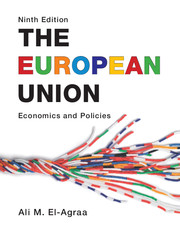Book contents
- Frontmatter
- Contents
- Figures
- Tables
- Boxes
- Contributors
- Preface
- A reader’s guide
- Abbreviations
- 1 General introduction
- Part I EU history, institutions and legal dimension
- Part II EU market integration
- Part III EU monetary integration
- Part IV The single European market
- 13 Competition policy
- 14 Industrial and competitiveness policy
- 15 Tax harmonization
- 16 Transport policy
- 17 Energy policy and energy markets
- 18 Environmental policy
- Part V EU budget and structural policies
- Part VI EU external relations
- Part VII The future of the EU
- Bibliography
- Author Index
- Index
- References
14 - Industrial and competitiveness policy
the Lisbon Strategy
from Part IV - The single European market
- Frontmatter
- Contents
- Figures
- Tables
- Boxes
- Contributors
- Preface
- A reader’s guide
- Abbreviations
- 1 General introduction
- Part I EU history, institutions and legal dimension
- Part II EU market integration
- Part III EU monetary integration
- Part IV The single European market
- 13 Competition policy
- 14 Industrial and competitiveness policy
- 15 Tax harmonization
- 16 Transport policy
- 17 Energy policy and energy markets
- 18 Environmental policy
- Part V EU budget and structural policies
- Part VI EU external relations
- Part VII The future of the EU
- Bibliography
- Author Index
- Index
- References
Summary
Introduction
Industrial and competitiveness policy (ICP) can be defined as government policy designed to improve a country’s economic performance. This includes a very broad range of government policies, both horizontal, to provide a supportive environment for business (fiscal, competition, regional, social, labour and environmental policies), and vertical, designed to favour particular sectors of the economy.
ICP has fluctuated over time. From 1950 to 1979 the prevailing orthodoxy was that government could and should correct market failures, so microeconomic intervention in specific industrial sectors was normal. Thus in the 1970s the response to structural change in the world economy was protection of companies and industries in difficulty, and European industrial policies ‘aimed to create European super-firms to compete with the US giants’ (Geroski and Jacquemin 1989, p. 299). The failure of these policies to raise EU industrial performance meant that by the 1980s the effectiveness of government action was increasingly questioned. By the early 1990s, in the Commission’s view, ICP ‘should promote adaptation to industrial change in an open and competitive market’ (Bangermann 1994). So company and sector-specific policies were viewed with suspicion, and ICP supported competitive markets in general. Today the consensus is between these extremes of extensive intervention and relying on market forces: ICP can be a helpful tool to improve economic performance, provided it is used sparingly and carefully (Buigues and Sekkat 2009; Lin and Monga 2010).
- Type
- Chapter
- Information
- The European UnionEconomics and Policies, pp. 214 - 228Publisher: Cambridge University PressPrint publication year: 2011
References
- 2
- Cited by

